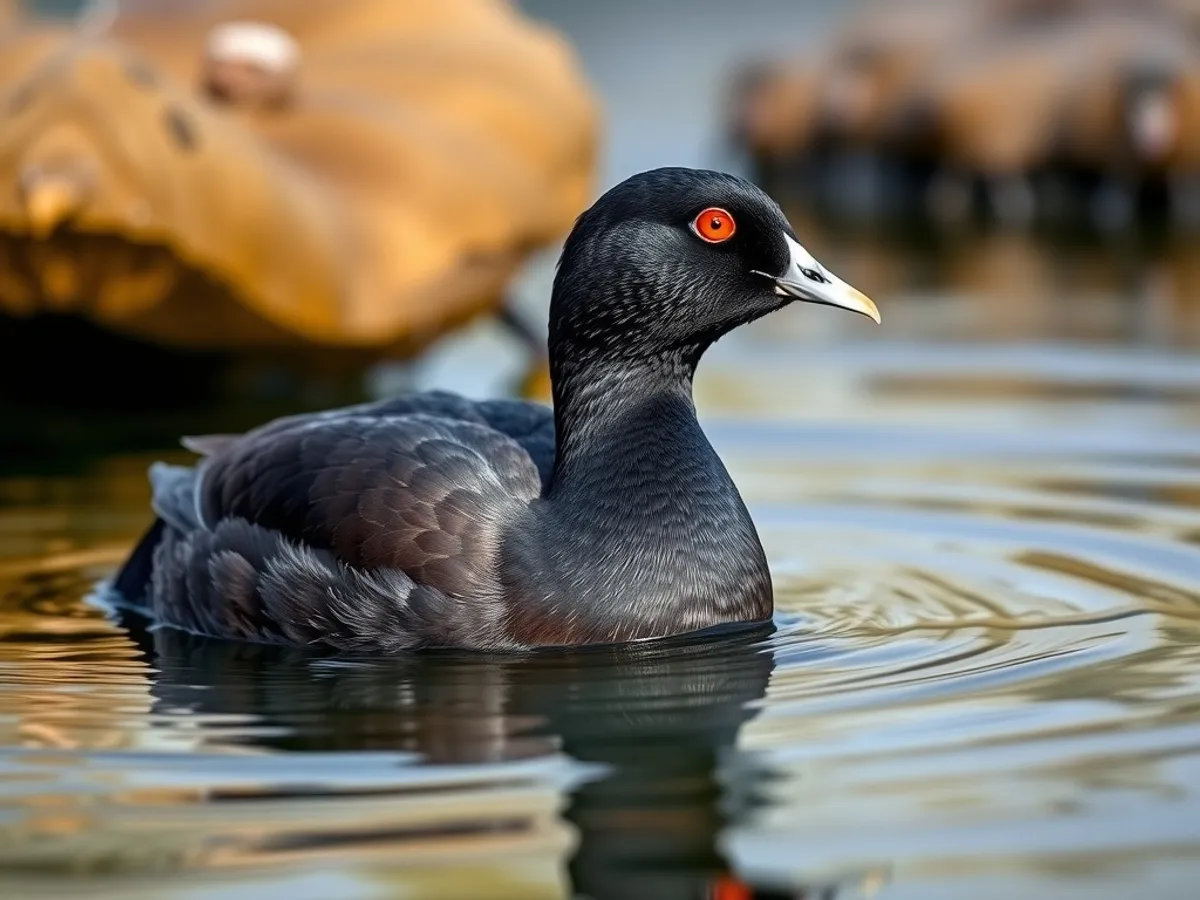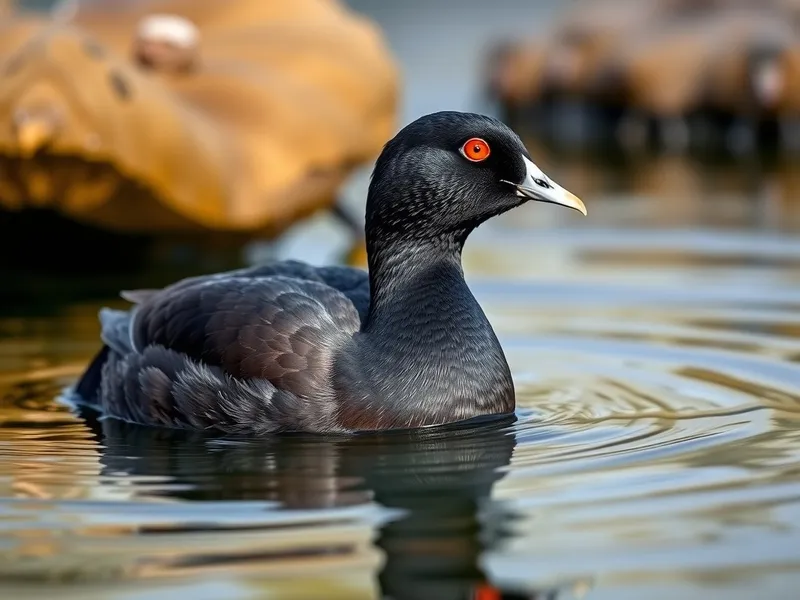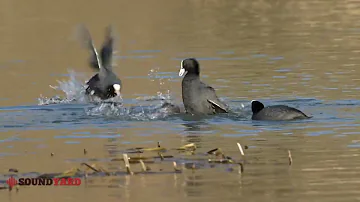
Eurasian Coot
Fulica atra

Meet the Eurasian Coot
The Eurasian Coot is a medium-sized waterbird easily recognized by its black plumage and distinctive white facial shield and bill. Common across Europe, Asia, Australia, and parts of North Africa, it frequents freshwater lakes, ponds, and slow-moving rivers with abundant aquatic vegetation. Coots are known for their aggressive territorial behavior, especially during breeding season, and their ability to dive underwater to forage for food. They are strong swimmers thanks to their lobed toes, which also allow them to walk on floating vegetation. Highly adaptable, the Eurasian Coot is a familiar sight in both urban and rural wetlands.
Classification
Bird
Habitat
Freshwater lakes, ponds, slow rivers, and marshes
Diet
Omnivore
Lifespan
5-15 years
Conservation
Least Concern
Weight
600-1,200 g
📖Fascinating Facts
Unique Feet
Unlike ducks, the Eurasian Coot has lobed toes instead of fully webbed feet, aiding in swimming and walking on muddy or floating vegetation.
Parental Aggression
During breeding season, coot parents can become so aggressive that they may attack their own chicks if food is scarce.
Wide Distribution
The Eurasian Coot is found across three continents: Europe, Asia, and Australia, making it one of the most widespread members of the rail family.
📋Detailed Description
The Eurasian Coot (Fulica atra) is a robust, medium-sized waterbird, typically measuring 36–38 cm in length with a wingspan of 70–80 cm and weighing between 585–1,100 grams. It is characterized by its sooty-black plumage, rounded body, and a distinctive white frontal shield that extends from the base of its short, conical bill. Both sexes are similar in appearance, though males are generally slightly larger. The coot’s eyes are a striking red, and its legs are greenish with lobed toes, which are not webbed but have broad flaps that aid in swimming and walking on floating vegetation. In flight, coots appear heavy and require a running start across the water to become airborne. Their vocalizations are loud and varied, including sharp 'kew-kew' calls and grating croaks, especially during territorial disputes. The species is highly gregarious outside the breeding season, forming large flocks that can number in the thousands. Eurasian Coots are omnivorous, feeding on aquatic plants, algae, small invertebrates, and occasionally the eggs and chicks of other waterbirds. They are aggressive and territorial during the breeding season, often engaging in fierce fights using their feet and bills. Their adaptability to a wide range of freshwater habitats, including urban parks, has contributed to their widespread distribution and stable population.
💡 Did you know?
Although Eurasian Coots are excellent swimmers, they are also capable of flying long distances and are known to migrate across continents.
🔬Research & Sources
Wikipedia Summary
The Eurasian coot, also known as the common coot, or Australian coot, is a member of the rail and crake bird family, the Rallidae. It is found in Europe, Asia, Australia, New Zealand and parts of North Africa. It has a slaty-black body, a glossy black head and a white bill with a white frontal shield. The sexes are similar. Similar looking coot species are found throughout the world, with the largest variety of coot species living in South America.
Last Modified: 5/16/2025
🎭Behavior & Social Structure
Eurasian Coots display complex social behaviors, shifting from solitary or paired territoriality during breeding to highly social flocking in the non-breeding season. They are diurnal, spending most daylight hours foraging by diving or upending in shallow water, and grazing on land near water bodies. Coots are known for their aggressive defense of territories, especially during the breeding season, when they will chase, peck, and even drown intruders, including other coots. Their feeding strategy is opportunistic; they consume submerged vegetation, seeds, insects, mollusks, and occasionally scavenge. Coots use their lobed toes to swim efficiently and to walk on floating leaves. They communicate with a variety of calls and visual displays, such as raising their white frontal shield to signal aggression or dominance. Outside the breeding season, coots often roost communally on open water, sometimes forming dense nocturnal rafts.
👶Reproduction & Life Cycle
Eurasian Coots are monogamous, forming seasonal pair bonds that may persist for several years. Breeding typically occurs from March to July in temperate regions, but timing varies with latitude and local climate. Pairs establish and defend territories, constructing bulky nests from reeds and plant material, usually anchored to emergent vegetation in shallow water. Females lay 6–10 eggs per clutch, which are pale buff with dark speckles. Both parents share incubation duties over 21–24 days. After hatching, chicks are precocial but remain dependent on parents for food and protection. Chicks are covered in black down with bright red and orange facial skin, which fades as they mature. Fledging occurs at 55–60 days, but young may remain with parents for several weeks. Coots are known for brood reduction: in times of food scarcity, weaker chicks may be neglected or even killed by parents or siblings, a behavior thought to maximize reproductive success under variable conditions.
🛡️Adaptations & Survival
The Eurasian Coot exhibits several adaptations for an aquatic lifestyle. Its lobed toes, unlike the fully webbed feet of ducks, provide excellent propulsion in water and stability on floating vegetation. The dense, waterproof plumage insulates against cold water. The white frontal shield is used in social signaling and territorial disputes. Coots have strong, muscular legs set far back on the body, optimizing swimming but making walking somewhat awkward. Their aggressive territoriality and ability to exploit a wide range of food sources, including human-provided resources, have enabled them to thrive in diverse and even heavily modified habitats. Physiologically, coots can tolerate low-oxygen environments, allowing them to exploit eutrophic or polluted waters where other species may decline.
📚Research Sources
🎨Cultural Significance
The Eurasian Coot appears in European folklore and idiomatic language, often symbolizing stubbornness or foolishness—hence the English phrase 'bald as a coot,' referencing the bird’s white shield. In some cultures, coots have been hunted for food, and their eggs collected. The species is sometimes regarded as a pest in managed fisheries or ornamental lakes due to its aggressive behavior and grazing on aquatic plants. In Australia, the coot is a familiar sight in urban parks and wetlands, often featured in local birdwatching guides and educational materials. There is no significant mythological or religious role attributed to the species.
🔬Recent Research & Discoveries
Recent research on Eurasian Coots has focused on their aggressive brood reduction behavior, which provides insights into parental investment and sibling competition. Studies using GPS and radio telemetry have revealed detailed movement patterns, habitat use, and responses to urbanization. Genetic analyses have clarified the species’ relationships within the Rallidae family and highlighted low genetic differentiation across its vast range, suggesting high dispersal ability. Investigations into their role in aquatic ecosystems have shown that coots can influence plant community composition through selective grazing. Ongoing research addresses the impacts of climate change on breeding phenology and range shifts, as well as the effects of water pollution on health and reproductive success.
🎥Wildlife Videos

The Eurasian coot, short film.
This short film shows and talks about the Coot. it's become clear to the many people I speak to and from what I have witnessed ...
The Wonders Of Nature

Things you need to know about COOTS!
Coots are a common sight on ponds, lakes and rivers around the UK. They are also found throughout mainland Europe, Asia, ...
A Shot Of Wildlife

Eurasian coot Birds - The Blue Dot
This video is introduction of Eurasian coot birds, these birds spent their lives in water bodies. Feel free to give suggestions.
The Blue Terra

Eurasian Coot || Planet N Nature #shorts
Eurasian Coot || Planet N Nature The Eurasian coot (Fulica atra), also known as the common coot, or Australian coot, is a member ...
Planet N Nature

Intense Battle Between Eurasian Coot Birds | Amazing Common Coot Fight in the Wild
Intense Battle Between Eurasian Coot Birds | Amazing Common Coot Fight in the Wild Watch an incredible showdown between ...
SoundYard

Common coot Il Eurasian coot Il swamp chicken Il Wildlife Il Wild Animals Il Beautiful Earth 4K🌍
Common coot Il Eurasian coot Il swamp chicken Il Wildlife Il Wild Animals Il Beautiful Earth 4K #birds #wildanimals #wildlife ...
Beautiful Earth 🌍
🌍Habitat Information
The Eurasian Coot typically inhabits Freshwater lakes, ponds, slow rivers, and marshes environments. Eurasian Coots have adapted to their environments with specialized features and behaviors.
Primary Habitat:
Freshwater lakes, ponds, slow rivers, and marshes
More detailed habitat information will be available soon.
🛡️Conservation Status
The Eurasian Coot is currently classified as Least Concern. Conservation efforts are crucial for preserving this species for future generations.
Common Threats:
- 🏠Habitat loss and fragmentation
- 🌡️Climate change impacts
- 🎯Hunting and poaching
- 🏭Human-wildlife conflict
⚠️Threats & Conservation Challenges
Currently classified as Least Concern by the IUCN, the Eurasian Coot faces localized threats such as habitat loss due to wetland drainage, water pollution, and disturbance from recreational activities. In some regions, predation by introduced mammals (e.g., foxes, rats) and birds of prey can impact breeding success. Eutrophication and algal blooms, often caused by agricultural runoff, may alter food availability and nesting sites. However, their adaptability and generalist feeding habits have allowed populations to remain stable or even increase in many areas, particularly where artificial water bodies have been created. In parts of their range, coots are hunted for sport or food, but this is not considered a significant threat at the global level.
🔬Scientific Classification
Scientific Name
Fulica atra
Classification Hierarchy
🔍 About Taxonomic Classification
Taxonomic classification is a hierarchical system used by scientists to classify and organize living organisms based on shared characteristics and evolutionary relationships.
The system moves from broad categories (Kingdom) to increasingly specific ones, with each animal's scientific name typically consisting of its Genus and species.
📝Community Notes
Share your observations and insights about the Eurasian Coot with our community of wildlife enthusiasts.
Join Our Community
Sign in to share your observations and connect with fellow wildlife enthusiasts.
Sign In to ContributeNo community notes yet
Be the first to share your observations about the Eurasian Coot!
Explore Eurasian Coot
Select a tab above to learn more about this amazing animal.
📸Photo Gallery
No photos available for this animal yet.
🌟Discover More Wildlife
Continue your journey of discovery with more fascinating animals from our database
